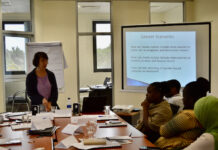
The importance of language
This is another training module from The News Manual, part of a series reproduced on this site about language and style in news writing. In this modules, we offer guidance on how to write sentences for maximum understanding and why care over language is important.
Your main task as a journalist is to help people understand what is happening around them; in their village, in their country and in the world. Most readers or listeners will not have your knowledge of language, so you must simplify it for them.
You should be able to examine the most complicated issues and events, then translate them into language which your audience can understand. If you fail in this, people will stop buying your newspaper or tuning in to your radio or television station. You will be failing in your job.
For many journalists today, English is the main language used for newspapers or magazines, radio, television or the Internet. This training module is written in English, so it concentrates on the English language. It is worth remembering, however, that even a language as common as English is not exactly the same all over the world.
There are differences between, for example, UK English and American English. There are often also differences in the way English is written or spoken within individual countries. It may sometimes be difficult to decide what is correct in the English used in your country.
Language is developing all the time, and your country may not yet have a well-established set of rules for English. If this is so, you should use the form which is accepted as correct by the most literate educated people in your country. Above all, use words and grammar which are most easily understood by your readers or listeners.
Although you are reading this in English, you may do a lot of writing in other languages. Many of the general points we make about writing style will apply to these other languages. Learn the general points and try to apply them to your own language or languages.
You may get some guidance on such things as sentence length, punctuation or word usage from your organisation’s style books. These are books which lay down rules for language you must follow in your particular paper or broadcasting station.
You should ask your editor or chief of staff for a copy of your organisation’s style book. Unfortunately, many small or new organisations do not have their own style book. In these chapters, we try to give you some general guidelines for language use and writing style. Use this advice to create your own style guide.
Short, sharp, clear sentences
Whether you write for newspapers, broadcasting or the Internet, you should always aim for words and sentences which provide the maximum amount of understanding with the minimum risk of confusion.
This generally means keeping words and sentences short and simple. You can use long words, but you must be sure they are doing their job properly. There is no room in your sentences for fat and lazy words. If words do not add to understanding, get rid of them.
Sentence length
There is no single rule about the length of sentences in news writing, but you should set yourself a target for the maximum number of words you use.
We suggest that you never use more than 20 words in any sentence, except in special circumstances. If you follow this rule, your sentences will be simpler, there will be less room for error and you will make a more efficient use of words.
An alternative way of judging the best length for your sentences is to count the number of ideas or concepts you expect your reader or listener to understand. Compare these two examples of the same story. Notice how version A tries to pack all the ideas into one sentence, whereas version B splits them into three separate sentences:
Story A: Four aircraft passengers, the pilot and three people travelling in a car were killed when a twin-engined Beechcraft Baron aircraft hit an electric power line and crashed near Nadi airport this week.
Story B: Eight people died when an aircraft crashed near Nadi airport this week.
The pilot and four passengers died when their twin-engined Beechcraft Baron hit a power line. The plane then crashed into a car on a road near the airport, killing three more people.
Notice that, although Story B is 12 words longer than Story A, it is split into three sentences. None of the sentences in Story B is longer than 20 words. Get someone to read both stories out loud to you, and you will quickly see that Story B is easier to understand.
The reason is simple. Story A contains six separate ideas for the reader or listener to understand at one time:
- the people in the plane;
- the people in the car;
- the type of plane;
- the cause of the crash;
- the location of the crash;
- the time of the crash.
Story B, by comparison, has fewer ideas in each sentence. The first sentence has just four simple ideas:
- the total number of dead;
- a simple description of the type of plane;
- where it crashed;
- when it crashed.
The second sentence tells us:
- how many died in the plane;
- the exact type of plane;
- the exact cause of the crash.
The third sentence tells us:
- how the people in the car died;
- where the car was;
- how many died in the car.
You may argue that Story B, as well as being longer, gives a total of ten ideas to understand. However, many of those ideas are not separate. They relate to details in the preceding sentence. Linking ideas and repeating details often helps understanding. More important, those ten ideas are not thrown at our audience in one breath. The full stop at the end of each sentence (which comes as a pause on radio and television) allows the reader or listener time to digest one set of facts before moving on to new details.
We recommend that you try to limit each sentence to no more than three separate ideas. You can occasionally use four ideas per sentence, as long as those ideas are not complicated. We fitted four ideas into the intro of Story B above because two of the ideas – the time and place – are very simple and easy for the reader to understand.
Lively language
The words you use will help to make your story easy to understand. Long words are not bad in themselves, if they are the only words available to explain a particular meaning accurately. However, the English language is large and varied so there are usually shorter alternatives which do the job just as well as long words.
Many young journalists think that they have to use the whole of their vocabulary when writing even the simplest news story. You may wish to show off your knowledge of the language, but your knowledge is not what matters. The vocabulary of your reader or listener is more important.
Some journalists also believe that they can only add drama or depth to a story by adding words. We get sentences like:
The man ran swiftly across the street to help the defenceless boy who was being brutally beaten.
Take out the adjectives and adverbs in italics. They are unnecessary and only slow the sentence down. The word swiftly is unnecessary because people do not usually run slowly. The boy is obviously defenceless, otherwise he would not be being beaten. And the word brutally is unnecessary, as most beatings are brutal. The sentence is now much livelier and sharper:
The man ran across the street to help the boy who was being beaten.
The most effective way to add drama to a sentence is to choose the verbs carefully. For example, try changing the verb “ran” to “strolled”, “walked”, “flew” or “thundered”. See how they alter the whole picture of what happened. We do not suggest that you change verbs simply to add drama. Every word must accurately describe what happened. But it is better to choose the correct verb than to add unnecessary adjectives and adverbs. The use of a variety of verbs is most common in sports reporting, where we read of players kicking, shooting, powering or rocketing the ball into the net.
Using new words
Many careless writers introduce new words without thinking how they will be understood. Sometimes they change nouns into verbs, in order to make sentences shorter. The danger with this is that the resultant verb is often less precise than the original phrase and is less readily understood by people. Avoid using verbs such as:
To author (use to write)
To hospitalise (use to admit to hospital or to be in hospital)
To parent (use to be a parent or to act like a parent)
You must be very careful about introducing new words which your readers or listeners might not understand. This is especially important if the word is in their second language. Stay with familiar words.
However, if you cannot avoid using a new word, you must follow it immediately with an explanation. For example, many English language newspapers and broadcasters use the Russian word glasnost quite freely when speaking of the changes in the Soviet Union. When they first began to use it, they needed to explain that glasnost means “the opening up of a society which has previously been rigidly controlled”.
There are also times when new words or usages have been readily accepted by society before the media decide to use them. It would be foolish, for example, to fight against the use of farewell as a verb in the South Pacific. People often speak of `farewelling a friend’.
Sentence structure
It is not enough to write short sentences using simple words. You also have to construct your sentences in such a way that the ideas are easy to understand.
The sentence “the man hit the table” is in the active voice (where the man is the hitter). The sentence “the table was hit by the man” is in the passive voice. Wherever possible, write in the active voice. That is the way most people speak. People do not say “the bus was missed by me”, they say “I missed the bus”.
However, there are times when you cannot avoid using the passive voice. This is particularly so when it is not clear who is responsible for the action or when the subject of the sentence is unimportant or unclear. For example we would write:
Three children have been admitted to hospital with suspected food poisoning. (Passive voice)
It would be wrong to use either of the following versions, the first because it is not clear who admitted them (was it a doctor or a nurse?), the second because we are not sure that it was food poisoning:
Someone admitted three children to hospital with suspected food poisoning.
or:
Food poisoning put three children in hospital.
Other factors which can make sentences too complicated for your reader or listener to understand include:
Subordinate clauses
You should avoid starting a sentence with a subordinate clauses. Subordinate clauses usually begin with words such as “while…”, “as…”, “although…”, “even though…”, “because …” and “despite…”. They are separate phrases within a sentence which help to put the main part of the sentence in context. In the following example of bad sentence construction, the subordinate clause is in italics:
BAD: Although there has been a 20 percent increase in murders this year, the Prime Minister has vowed not to bring back hanging.
The main point of the sentence is that the Prime Minister has said he will not bring back hanging. The subordinate clause sets this promise in the context of the rising crime rate. In the example above, putting the subordinate clause at the beginning of the sentence may confuse your readers or listeners. They expect to hear the main facts first. Rewrite the sentence as follows:
BETTER: The Prime Minister has vowed not to bring back hanging, despite a 20 percent increase in murders this year.
And and but
Even simple joining words like and and but can cause confusion if they are not used wisely. These words are called conjunctions because they join things together. The word and is quite acceptable when used to join together two words or phrases:
The man and the woman had two daughters and a son.
However, it should not be used to join together long lists of ideas which can quite easily be split into separate sentences. In the two examples which follow, the first version is confused by using and and but. By splitting it into separate sentences we do not alter the meaning, we simply make it easier to understand, for reasons we discussed in the section on sentence length:
RIGHT: Import duty on meat and vegetables will be reduced by ten percent.
The special subsidy for rice exporters will be increased by five percent. These changes will come into effect after the next budget.
WRONG: Duty on imported meat and vegetables will be reduced by ten percent and the special subsidy for rice exporters will be increased by five percent but these changes will not come into effect until after the next budget.
Paired negatives
Paired or double negatives in English are not only bad grammar (“he has not got no pawpaw”), they usually create confusion, especially in the spoken word. Although logically paired negatives simply cancel each other out, many people do not use them in this way. Many other languages have totally different rules about paired negatives, and even some British dialects use the paired negative to add stress to a negative idea.
For example, the sentence “He was happy” is easy to understand. So is the sentence “He was unhappy”. But what do you understand by “He was not unhappy”. Was he happy or unhappy? Do you see the confusion? Make it a rule: avoid paired negatives.
Objectivity
Your language must not only be easily understood, it must be fair. You should not use words which give a biased view of a person, an event or a situation.
Many words develop special, biased meanings because of the way they are commonly used in a community. In some cases, you cannot avoid using such words. Take care that the words you use reflect the meaning in the community and not your own opinions.
In particular, you should be careful about using words which describe disputes or conflicts. In these cases, each side to the dispute may choose to use the words which reflect well on them and badly on their opponents. As a journalist, you should try to steer the middle course.
The most obvious cases of bias are introduced by the use of adjectives and adverbs. A protester’s peaceful resistance may seem like violent obstruction to a policeman on duty. An injured person waiting for an ambulance may think it arrived slowly when the ambulance driver believes he drove fast.
Verbs too can be loaded with bias. The same protester who lobbed a stone at a police van may be seen by the men inside to have hurled it at them. A boss sees his workers go on strike, the workers may say they withdraw their labour. Words like sack, retrench and make redundant describe similar situations in which people lose their jobs, but they mean quite different things to the bosses and workers involved. Some American companies even speak of letting workers go, even though the workers themselves have no choice.
Nouns can also express bias. A building can be a house to a poor person, yet seem like a shack to the rich observer. It may seem to be in a suburb to its owner, and in a slum to the rich man. And who is rich? If you have $100 you will be rich to a beggar, but poor to a millionaire.
It is impossible to list all the words which may contain bias. You must look at each word individually and ask yourself if it is fair and accurate.
Quotes
You are on safer ground when you use words in quotes. That way the reader can judge the bias through the eyes of the person you quote. (In radio or television, it is better to use a recording of people speaking the actual words, called actuality.) In the following example, look at the difference between these two sentences describing the same crime. Notice how the magistrate and the accused see the crime in opposite ways:
The magistrate said: “These were mean and despicable thefts, carried out against a defenceless family for no good reason.”
The accused said: “I never robbed anyone. I just took from the rich people and gave it back to the poor.”
Do not pass judgment. Give the words in quotes and let you readers or listeners judge for themselves.
An added advantage of using quotes is that you can use much livelier language – the words the people themselves used.
To summarise
You must keep your language clear and simple so that your readers or listeners can understand.
Sentences should be short – no longer than 20 words or three concepts (ideas).
Sentence structure should be simple; it is best to write in the active voice.
Explain any new words whenever you use them.
This module is taken from The News Manual’s Chapter 10: Language & style basics.
Related training modules








